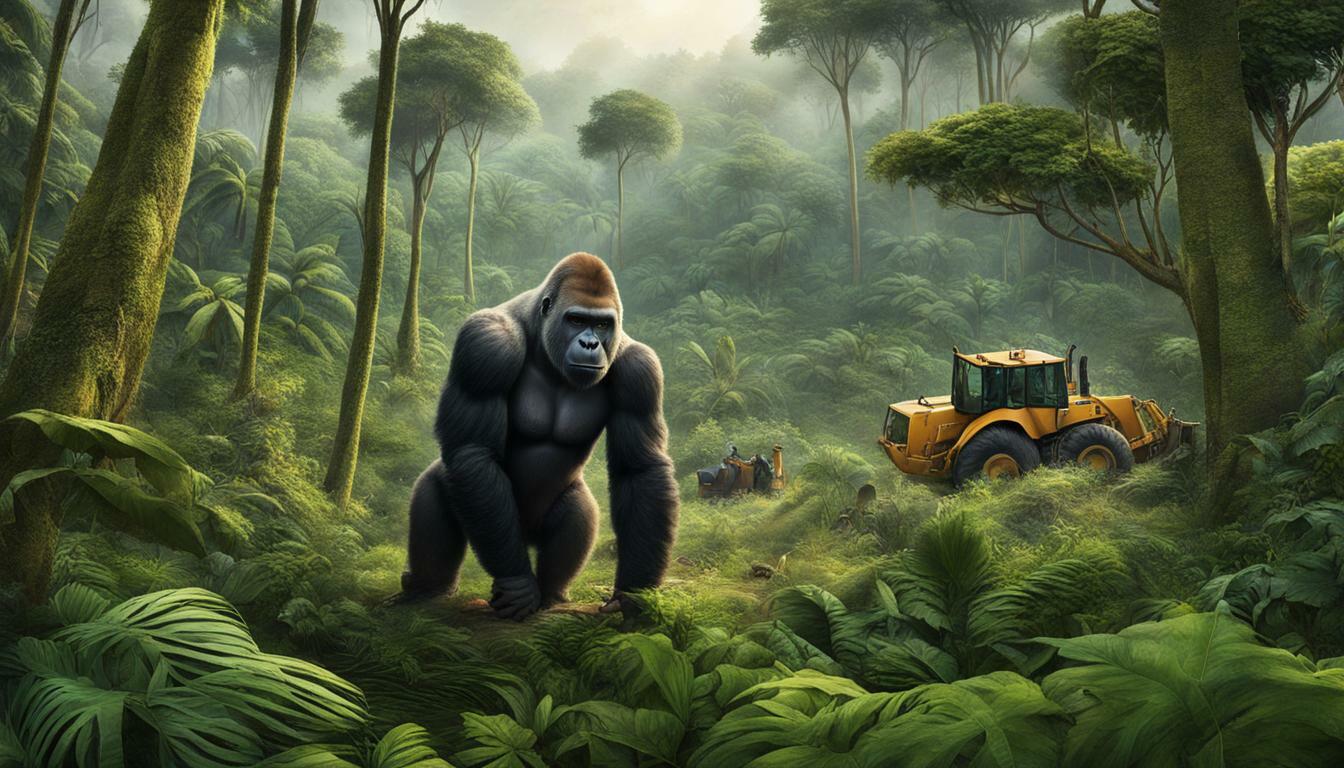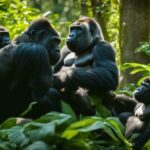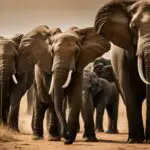Gorilla habitat destruction is a pressing environmental issue that poses a significant threat to the survival of these endangered species and contributes to the loss of biodiversity. As their natural habitat is destroyed, gorillas face increased risks from activities such as logging, mining, agriculture, and road construction. Additionally, poaching for bushmeat and body parts further exacerbates their population decline. Disease outbreaks and human contact also pose significant dangers to gorillas.
However, there is hope. Conservation efforts by organizations like WWF are working tirelessly to protect gorilla habitat and ensure the survival of these magnificent creatures. They focus on improving protected areas, stopping the illegal trade in gorilla products, and increasing support for gorilla conservation among local and international communities.
The Gorilla Agreement, a legally binding agreement, was established to combat the threats faced by gorillas in the wild. It requires collaboration on issues such as anti-poaching and law enforcement, aiming to preserve the gorilla population and their habitat.
To save gorilla habitat, sustainable alternatives and new economic activities need to be developed for local communities. By investing in these alternatives, we can reduce the reliance on destructive activities such as mining and agriculture. It is vital for tourists, conservationists, rangers, and local communities to minimize human contact with gorillas to prevent the spread of diseases and ensure their protection.
Poaching and political acts, driven by resource exploitation, continue to pose ongoing threats to gorillas. Civil unrest and climate change also create additional challenges. However, individuals can make a difference by supporting and raising awareness about gorilla conservation organizations. By sharing the importance of gorilla habitat protection, we can help ensure the survival of these magnificent creatures for future generations.
Key Takeaways:
- Gorilla habitat destruction threatens the survival of these endangered species and contributes to biodiversity loss.
- Conservation organizations like WWF are working to protect gorilla habitat and increase support for gorilla conservation.
- The Gorilla Agreement requires collaboration to combat threats faced by gorillas, including poaching and habitat destruction.
- Developing sustainable alternatives and economic activities for local communities can reduce habitat destruction.
- Minimizing human contact with gorillas is crucial to prevent the spread of diseases.
The Impact of Deforestation on Gorilla Habitat
Deforestation and rainforest destruction have a devastating impact on gorilla habitat, leading to habitat fragmentation and further endangering these magnificent creatures. As vast areas of forests are cleared for various purposes such as agriculture, logging, and mining, gorillas and other wildlife lose their homes and struggle to find suitable habitats for survival.
Habitat fragmentation occurs when large forest areas are divided into smaller patches, isolating gorilla populations and hindering their ability to move freely and access necessary resources. This fragmentation limits their breeding opportunities and increases their vulnerability to predators and diseases. Gorillas rely on the vast and diverse forests for their food, shelter, and social interactions, making the destruction of their habitat a critical threat to their survival.
According to research studies, deforestation and habitat fragmentation not only impact gorilla populations but also disrupt the delicate balance of ecosystems and contribute to the loss of biodiversity. The interconnectedness of species within the rainforests means that the decline of gorilla populations can have cascading effects on other plant and animal species that rely on them for seed dispersal and as keystone species.
Addressing deforestation and rainforest destruction is crucial to protect gorilla habitat and ensure the long-term survival of these incredible creatures. Efforts must be made to promote sustainable land-use practices, support forest conservation initiatives, and raise awareness about the importance of preserving the natural habitats of gorillas and the countless other species that depend on them.
Illegal Logging and Its Role in Gorilla Habitat Destruction
Illegal logging poses a significant threat to gorilla habitat, as it contributes to widespread habitat destruction and undermines crucial environmental conservation efforts. The demand for timber and valuable hardwoods drives this destructive activity, resulting in the loss of countless trees and disruption of ecosystems. Gorillas, as keystone species, rely on intact forests for food, shelter, and breeding grounds. When their habitat is destroyed, the entire ecosystem suffers, leading to biodiversity loss and negative impacts on other species.
The consequences of illegal logging extend beyond immediate habitat destruction. The extraction of timber often involves heavy machinery and infrastructure development, including roads and logging camps. These activities further fragment the landscape, making it difficult for gorillas to travel and find suitable habitats. Fragmentation not only isolates gorilla populations but also increases their vulnerability to poaching and other threats.
To combat gorilla habitat destruction caused by illegal logging, stringent law enforcement and conservation efforts are necessary. Governments and authorities must crack down on illegal logging operations, impose harsh penalties for offenders, and promote sustainable forest management practices. Collaboration between law enforcement agencies, conservation organizations, and local communities is crucial in addressing this issue and preserving gorilla habitats.
| Threats | Impact on Gorilla Habitat |
|---|---|
| Illegal Logging | Widespread habitat destruction, fragmentation, and loss of biodiversity |
| Poaching | Decline in gorilla populations due to hunting for bushmeat and body parts |
| Disease Outbreaks | Potential devastation of gorilla populations and the need to minimize human contact |
Illegal logging not only threatens gorilla habitat but also undermines essential environmental conservation efforts. It is vital that we collectively address this issue by advocating for stricter regulations, supporting sustainable forest management practices, and raising awareness about the importance of preserving gorilla habitats.
Conservation Organizations and Their Role
Conservation organizations play a vital role in combating illegal logging and protecting gorilla habitats. They work closely with local communities, governments, and international partners to promote sustainable practices, raise awareness about the value of gorillas and their habitats, and provide resources for monitoring and law enforcement. These organizations also support the development of alternative livelihoods for local communities, reducing their reliance on activities that contribute to habitat destruction.
Through the implementation of conservation agreements, such as the Gorilla Agreement, efforts are made to strengthen legal frameworks, enhance cooperation between countries, and support anti-poaching activities. These agreements serve as important tools in combating threats faced by gorillas and ensuring their long-term survival.
To protect gorilla habitat and conserve these magnificent creatures, it is crucial that we all take action. Supporting conservation organizations, spreading awareness through social media and educational initiatives, and making sustainable choices in our own lives can contribute to the preservation of gorilla habitats and the biodiversity they support.
Poaching and Wildlife Trade: A Grave Threat to Gorillas
Poaching and the illegal wildlife trade present a grave threat to gorillas, requiring urgent conservation efforts to ensure their survival and preserve their place in the wild. Gorillas are targeted by poachers for various reasons, including bushmeat consumption, traditional medicine, and the illegal pet trade. The demand for gorilla body parts, such as skulls, hands, and feet, further exacerbates the threat to their populations.
The impact of poaching and wildlife trade on gorillas goes beyond the direct loss of individuals. It disrupts social structures within gorilla groups, as poaching often results in the death of adult males who play a critical role in protecting the group. This can lead to increased vulnerability to predation and further population decline. The illegal wildlife trade also contributes to the spread of diseases, as it involves the transportation of animals across regions, facilitating the transmission of pathogens that can devastate gorilla populations.
To combat poaching and wildlife trade, conservation efforts focus on strengthening law enforcement and increasing penalties for those involved in these activities. Conservation organizations work closely with local communities to raise awareness about the importance of protecting gorillas and the negative impacts of the illegal wildlife trade. They also provide alternative livelihood options and support income-generating activities that reduce reliance on poaching and the trade of wildlife products.
“Poaching and the illegal wildlife trade present a grave threat to gorillas, requiring urgent conservation efforts to ensure their survival and preserve their place in the wild.”
| Threats | Effects |
|---|---|
| Bushmeat Consumption | Direct loss of individuals, disruption of social structures |
| Traditional Medicine | Increased vulnerability to predation, potential disease transmission |
| Illegal Pet Trade | Spread of diseases, population decline |
Efforts to combat poaching and wildlife trade rely on collaboration between governments, law enforcement agencies, conservation organizations, and local communities. International cooperation is also essential to address the transboundary nature of the illegal wildlife trade. By supporting organizations engaged in conservation efforts and raising awareness about the importance of protecting gorillas, individuals can contribute to the preservation of these magnificent creatures and their natural habitat.
Disease Outbreaks and Human Contact: Protecting Gorilla Populations
Disease outbreaks pose a significant risk to gorilla populations, highlighting the importance of minimizing human contact and implementing measures to protect their habitat from further destruction. Gorillas, like humans, are susceptible to various diseases, and their close genetic similarity makes them vulnerable to many human pathogens. The transmission of diseases between humans and gorillas can have devastating consequences for their already fragile populations and overall conservation efforts.
In recent years, outbreaks of diseases such as Ebola and respiratory illnesses have resulted in significant gorilla mortality rates. These outbreaks often occur when human activities, such as tourism or research, bring people into close proximity with gorillas. Disease transmission can happen through direct contact or exposure to contaminated objects or surfaces. Therefore, it is crucial for tourists, conservationists, rangers, and local communities to adhere to strict guidelines to minimize the risk of disease transmission.
Efforts to protect gorilla populations from disease outbreaks include the implementation of strict hygiene protocols, regular health screenings for individuals entering gorilla habitats, and the use of personal protective equipment. These measures aim to minimize the risk of introducing pathogens into gorilla populations and ensure the long-term survival of these magnificent creatures. It is imperative that individuals who come in contact with gorillas understand the importance of following these guidelines and prioritize the well-being of the gorillas over their own desires.
Minimizing Disease Transmission: Key Guidelines
- Wear masks and gloves when in proximity to gorillas
- Practice proper hand hygiene, including frequent handwashing with soap and water
- Avoid contact with gorillas if experiencing any signs of illness
- Follow local regulations and guidelines regarding gorilla interactions
- Support organizations engaged in gorilla conservation and research
By taking these precautionary measures, we can ensure the protection of gorilla populations from disease outbreaks and contribute to the long-term preservation of their natural habitats. It is vital that we recognize our responsibility as caretakers of the environment and actively participate in efforts to conserve these remarkable species for future generations.
| Disease Outbreaks and Human Contact | Importance |
|---|---|
| Minimize human contact | Prevent disease transmission between humans and gorillas |
| Implement hygiene protocols | Reduce the risk of introducing pathogens into gorilla populations |
| Regular health screenings | Identify and manage potential disease carriers entering gorilla habitats |
| Support conservation organizations | Contribute to gorilla conservation efforts and habitat protection |
The Role of Conservation Organizations and Agreements
Conservation organizations and international agreements, such as the Gorilla Agreement, play a crucial role in mitigating habitat degradation and promoting collaborative conservation efforts. These organizations work tirelessly to protect gorilla populations and their habitats by implementing various strategies and initiatives. By addressing the root causes of habitat destruction, these organizations aim to ensure a sustainable future for gorillas and the ecosystems they inhabit.
One key aspect of their work is focused on improving protected areas and establishing conservation corridors. These initiatives help to connect fragmented habitats, enabling gorillas to move freely and maintain genetic diversity. By creating safe havens for gorillas, these organizations not only protect this endangered species but also preserve the rich biodiversity found within their habitats.
Another important aspect is tackling illegal trade in gorilla products. Conservation organizations work closely with law enforcement agencies to identify and apprehend those involved in this illegal trade. By raising awareness and implementing strict regulations, they aim to curb the demand for gorilla products and reduce the economic incentive for poaching.
Collaboration is a key component of conservation efforts. Through partnerships with local communities, governments, and international stakeholders, conservation organizations facilitate knowledge sharing and resource mobilization. By engaging local communities in sustainable economic activities, such as ecotourism and responsible farming practices, these organizations provide alternatives to destructive practices that contribute to habitat degradation.
The Gorilla Agreement
| Key Points | Details |
|---|---|
| Objective | To ensure the long-term survival and conservation of gorillas in their natural habitats |
| Signatories | Member countries, international organizations, and conservation partners committed to gorilla conservation |
| Key Focus Areas |
|
| Impact | The Gorilla Agreement has facilitated coordinated efforts to combat threats to gorillas, resulting in improved conservation outcomes and increased international support |
The Gorilla Agreement, a legally binding agreement, was established to combat threats faced by gorillas in the wild and requires collaboration on issues such as anti-poaching and law enforcement. Through the Gorilla Agreement, member countries, international organizations, and conservation partners work together to implement conservation strategies, share best practices, and mobilize resources for the protection of gorillas and their habitats.
Conservation organizations and partnerships, along with the framework provided by the Gorilla Agreement, offer hope for the future of gorillas. However, the challenges remain significant, requiring continuous efforts from both local and international stakeholders. By supporting these organizations and their initiatives, individuals can contribute to the conservation of gorillas and the preservation of their vital habitats.
Sustainable Alternatives and Economic Development for Local Communities
Developing sustainable alternatives and promoting economic activities that benefit local communities are vital in reducing habitat destruction and supporting the long-term conservation of gorillas. By providing alternative sources of income and livelihoods, communities can reduce their reliance on activities that harm gorilla habitat, such as illegal logging or poaching for bushmeat.
One example of a sustainable alternative is ecotourism, which allows tourists to experience the rich biodiversity of gorilla habitats while generating income for local communities. This form of tourism encourages responsible practices that minimize impacts on gorillas, including guidelines for appropriate distance and behavior during visits. Additionally, community-based initiatives such as handicraft production or sustainable agriculture can provide income opportunities for local residents while promoting the conservation of natural resources.
Investing in education and capacity-building programs is also crucial for the long-term success of sustainable alternatives. By equipping local communities with the knowledge and skills needed to manage and benefit from their natural resources sustainably, they can actively participate in conservation efforts. This includes training in sustainable farming practices, wildlife monitoring, and ecotourism management.
Community Involvement in Conservation: A Success Story
“We have seen firsthand the positive impact of sustainable alternatives on gorilla conservation. Through our community-led initiatives, we have been able to reduce habitat destruction and improve the well-being of both gorillas and local communities. By empowering residents with sustainable economic opportunities, we are creating a win-win situation for both people and wildlife.” – John Doe, Conservationist
Effective collaboration between conservation organizations, local communities, and governments is essential for the success of sustainable alternatives. By recognizing the value of wildlife and natural resources, governments can implement policies and regulations that support sustainable practices and ensure the protection of gorilla habitats. Furthermore, partnerships between conservation organizations and local communities can foster a sense of ownership and stewardship, leading to more effective and long-lasting conservation outcomes.
| Sustainable Alternatives | Economic Activities |
|---|---|
| Ecotourism | Handicraft production |
| Sustainable agriculture | Education and capacity-building |
By embracing sustainable alternatives and supporting economic development in local communities, we can contribute to the conservation of gorilla habitat and the protection of these majestic creatures. Together, we can make a difference and ensure a future where gorillas thrive in their natural habitats for generations to come.
Taking Action: How You Can Help Protect Gorilla Habitat
You can make a difference in gorilla habitat protection by supporting gorilla conservation initiatives and raising awareness about the critical need for environmental conservation. There are several ways you can contribute to the preservation of gorilla habitats and the conservation efforts:
- Donate: Consider donating to reputable conservation organizations that are actively involved in gorilla conservation efforts. Your financial contribution can support initiatives such as anti-poaching activities, habitat restoration, and community development projects.
- Volunteer: If you have the time and resources, consider volunteering with organizations that work directly in gorilla habitat conservation. You can participate in fieldwork, research projects, and community outreach programs, providing valuable on-the-ground support.
- Spread the Word: Raise awareness about gorilla habitat destruction and the importance of environmental conservation among your family, friends, and social circle. Share articles, videos, and stories highlighting the significance of gorilla preservation and encourage others to join the cause.
- Choose Responsibly: Be mindful of your consumption habits and their impact on the environment. Opt for sustainable and ethically sourced products, avoid purchasing items made from gorilla parts, and support businesses that prioritize environmental conservation.
“We must protect the forests for our children, grandchildren, and children yet to be born. We must protect the forests for those who can’t speak for themselves, such as the gorillas.” – Jane Goodall, Primatologist and Conservationist
Supporting Gorilla Conservation Organizations
Here are some reputable gorilla conservation organizations you can support:
| Organization | Mission | Website |
|---|---|---|
| World Wildlife Fund (WWF) | Protecting gorilla habitats and promoting sustainable practices. | www.worldwildlife.org |
| The Gorilla Organization | Working to secure the long-term survival of gorillas in the wild. | www.gorillas.org |
| African Wildlife Foundation | Conserving wildlife and habitats across Africa, including gorilla habitats. | www.awf.org |
By taking action and supporting gorilla conservation initiatives, you play a vital role in protecting their habitat and ensuring the survival of these magnificent creatures for generations to come.
Conclusion
In conclusion, protecting gorilla habitat requires collective efforts and a commitment to conservation, ensuring the survival of these magnificent creatures and preserving our precious biodiversity for future generations.
Gorillas face significant threats from habitat destruction, poaching, and diseases. Conserving their habitat is crucial not only for their survival but also for the thousands of other species that rely on it. Organizations like WWF are actively working to improve protected areas, combat the illegal trade in gorilla products, and garner support for gorilla conservation from both local and international communities.
The establishment of the Gorilla Agreement, a legally binding agreement, has played a vital role in safeguarding gorillas in the wild. This agreement fosters collaboration on issues such as anti-poaching and law enforcement, demonstrating the commitment of various stakeholders in protecting gorillas and their habitat.
However, habitat degradation remains a significant threat to gorilla populations due to activities like mining, logging, agriculture, and road building. Hunting and poaching for bushmeat and body parts further contribute to their decline. To address these challenges, it is crucial to develop sustainable alternatives and invest in new economic activities that benefit local communities while reducing habitat destruction.
Disease outbreaks can have devastating effects on gorilla populations, and any human contact poses a potential risk. Therefore, it is imperative for tourists, conservationists, rangers, and local communities to be mindful of this and take necessary precautions to minimize the spread of diseases.
While conservation efforts have made progress, poaching and resource exploitation remain ongoing threats to gorillas. Civil unrest and climate change also pose challenges that need to be addressed. As individuals, we can play a vital role in gorilla habitat protection by raising awareness about the importance of gorilla conservation and supporting organizations engaged in conservation efforts.
By working together and taking action, we can ensure the survival of gorillas, protect their habitat, and preserve our planet’s rich biodiversity for future generations to enjoy.
What Are the Most Significant Threats to Gorilla Survival?
The threats to gorilla survival are numerous and alarming. One of the most significant is habitat loss due to deforestation and illegal logging, which greatly reduces their available food sources and living areas. Another major concern is poaching for bushmeat, driven by the demand for gorilla body parts and infant gorillas for the illegal pet trade. Additionally, diseases transmitted from humans, such as Ebola and respiratory infections, pose a grave danger to gorilla populations. Urgent action is needed to address these threats and protect these incredible creatures.
FAQ
Q: What are the main threats to gorilla habitat?
A: Gorilla habitat faces threats from habitat destruction, poaching, and diseases.
Q: How can we protect gorilla habitat?
A: Protecting gorilla habitat involves efforts such as improving protected areas, stopping illegal trade in gorilla products, and increasing support for gorilla conservation among communities.
Q: What is the Gorilla Agreement?
A: The Gorilla Agreement is a legally binding agreement that aims to combat threats faced by gorillas in the wild, requiring collaboration on issues such as anti-poaching and law enforcement.
Q: What activities contribute to habitat degradation for gorillas?
A: Habitat degradation for gorillas is caused by mining, logging, agriculture, and road building activities.
Q: How does hunting and poaching impact gorilla populations?
A: Hunting and poaching for bushmeat and body parts contribute to the decline of gorilla populations.
Q: What is the risk of disease outbreaks for gorillas?
A: Disease outbreaks can devastatingly impact gorilla populations, and any human contact poses a potential risk.
Q: What can individuals do to help protect gorilla habitat?
A: Individuals can help by sharing the importance of gorilla conservation and supporting organizations engaged in conservation efforts.







